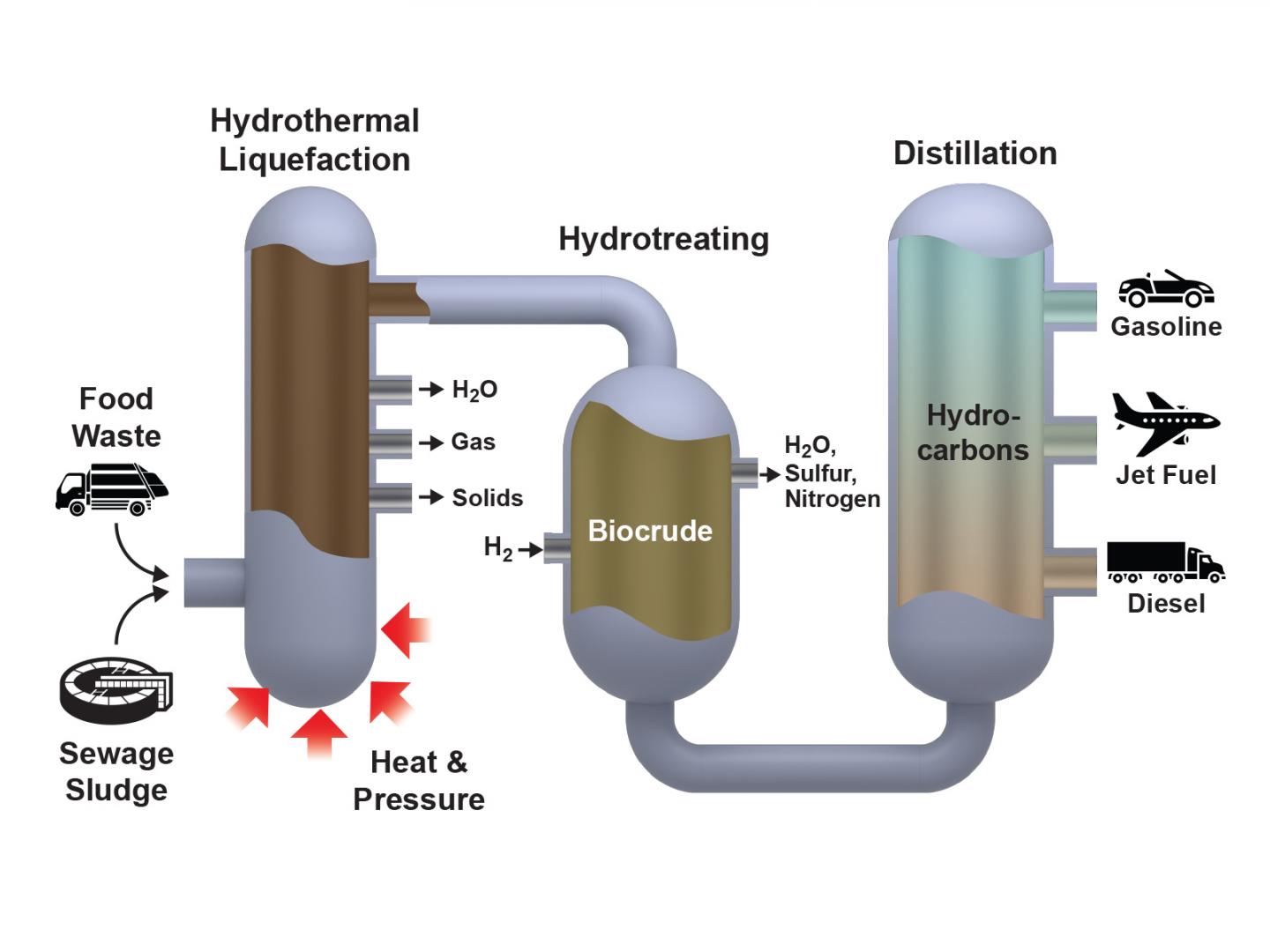Author:
DOE/Pacific Northwest National Laboratory
Date
03/28/2021

Wet wastes from sewage treatment and discarded food can provide the raw materials for an innovative process called hydrothermal liquefaction, which converts and concentrates carbon-containing molecules into a liquid biocrude. This biocrude then undergoes a hydrotreating process to produce bio-derived fuels for transportation.
A large-scale demonstration converting biocrude to renewable diesel fuel has passed a significant test, operating for more than 2,000 hours continuously without losing effectiveness. Scientists and engineers led by the U.S. Department of Energy's Pacific Northwest National Laboratory conducted the research to show that the process is robust enough to handle many kinds of raw material without failing.
"The biocrude oil came from many different sources, including wastewater sludge from Detroit, and food waste collected from prison and an army base," said John Holladay, a PNNL scientist and co-director of the joint Bioproducts Institute, a collaboration between PNNL and Washington State University. "The research showed that essentially any biocrude, regardless of wet-waste sources, could be used in the process and the catalyst remained robust during the entire run. While this is just a first step in demonstrating robustness, it is an important step."
The milestone was first described at a virtual conference organized by NextGenRoadFuels, a European consortium funded by the EU Framework Programme for Research and Innovation. It addresses the need to convert biocrude, a mixture of carbon-based polymers, into biofuels. In the near term, most expect that these biofuels will be further refined and then mixed with petroleum-based fuels used to power vehicles.
"For the industry to consider investing in biofuel, we need these kinds of demonstrations that show durability and flexibility of the process," said Michael Thorson, a PNNL engineer and project manager.
Biocrude to biofuel, the crucial conversion
Just as crude oil from petroleum sources must be refined to be used in vehicles, biocrude needs to be refined into biofuel. This step provides the crucial "last mile" in a multi-step process that starts with renewables such as crop residues, food residues, forestry byproducts, algae, or sewage sludge. For the most recent demonstration, the biocrude came from a variety of sources including converted food waste salvaged from Joint Base Lewis-McChord, located near Tacoma, Wash., and Coyote Ridge Corrections Center, located in Connell, Wash. The initial step in the process, called hydrothermal liquefaction, is being actively pursued in a number of demonstration projects by teams of PNNL scientists and engineers.
The "last mile" demonstration project took place at the Bioproducts, Sciences, and Engineering Laboratory on the Richland, Wash. campus of Washington State University Tri-Cities. For 83 days, reactor technician Miki Santosa and supervisor Senthil Subramaniam fed a constant flow of biocrude into carefully honed and highly controlled reactor conditions. The hydrotreating process introduces hydrogen into a catalytic process that removes sulfur and nitrogen contaminants found in biocrude, producing a combustible end-product of long-chain alkanes, the desirable fuel used in vehicle engines. Chemist Marie Swita analyzed the biofuel product to ensure it met standards that would make it vehicle-ready.
Diverting carbon to new uses
"Processing food and sewage waste streams to extract useful fuel serves several purposes," said Thorson. Food waste contains carbon. When sent to a landfill, that food waste gets broken down by bacteria that emit methane gas, a potent greenhouse gas and contributor to climate change. Diverting that carbon to another use could reduce the use of petroleum-based fuels and have the added benefit of reducing methane emissions.
The purpose of this project was to show that the commercially available catalyst could stand up to the thousands of hours of continuous processing that would be necessary to make biofuels a realistic contributor to reducing the world's carbon footprint. But Thorson pointed out that it also showed that the biofuel product produced was of high quality, regardless of the source of biocrude?an important factor for the industry, which would likely be processing biocrude from a variety of regional sources.
Indeed, knowing that transporting biocrude to a treatment facility could be costly, modelers are looking at areas where rural and urban waste could be gathered from various sources in local hubs. For example, they are assessing the resources available within a 50-mile radius of Detroit, Mich. There, the sources of potential biocrude feedstock could include food waste, sewage sludge and cooking oil waste. In areas where food waste could be collected and diverted from landfills, much as recycling is currently collected, a processing plant could be up to 10 times larger than in rural areas and provide significant progress toward cost and emission-reduction targets for biofuels.
Commercial biofuels on the horizon
Milestones such as hours of continuous operation are being closely watched by investor groups in the U.S. and Europe, which has set aggressive goals, including being the first climate-neutral continent by 2050 and achieving a 55% reduction in greenhouse gas emissions by 2030. "A number of demonstration projects across Europe aim to commercialize this process in the next few years," Holladay said.
The next steps for the research team include gathering more sources of biocrude from various waste streams and analyzing the biofuel output for quality. In a new collaboration, PNNL will partner with a commercial waste management company to evaluate waste from many sources. Ultimately, the project will result in a database of findings from various manures and sludges, which could help decide how facilities can scale up economically.
"Since at least three-quarters of the input and output of this process consists of water, the ultimate success of any industrial scale-up will need to include a plan for dealing with wastewater," said Thorson. This too is an active area of research, with many viable options available in many locations for wastewater treatment facilities.
EurekAlert!, the online, global news service operated by AAAS, the science society: https://www.eurekalert.org/pub_releases/2021-03/dnnl-bpt032421.php